Intro to Art - Images Study Guide Final Test 2023
5.0(1)
5.0(1)
Card Sorting
1/30
Earn XP
Study Analytics
Name | Mastery | Learn | Test | Matching | Spaced |
|---|
No study sessions yet.
31 Terms
1
New cards

\
\-Macchu Picchu
\-Unknown builder
\-Location; Inca, Peru
\-1450 - 1530
\-Stonework
\-Machu Picchu is an example of refined, enduring stonework
\-It was the ruler's summer home and rests 9,000 feet above sea level
\-The entire complex was designed with sensitivity to its surrounding landscape
\-Unknown builder
\-Location; Inca, Peru
\-1450 - 1530
\-Stonework
\-Machu Picchu is an example of refined, enduring stonework
\-It was the ruler's summer home and rests 9,000 feet above sea level
\-The entire complex was designed with sensitivity to its surrounding landscape
2
New cards
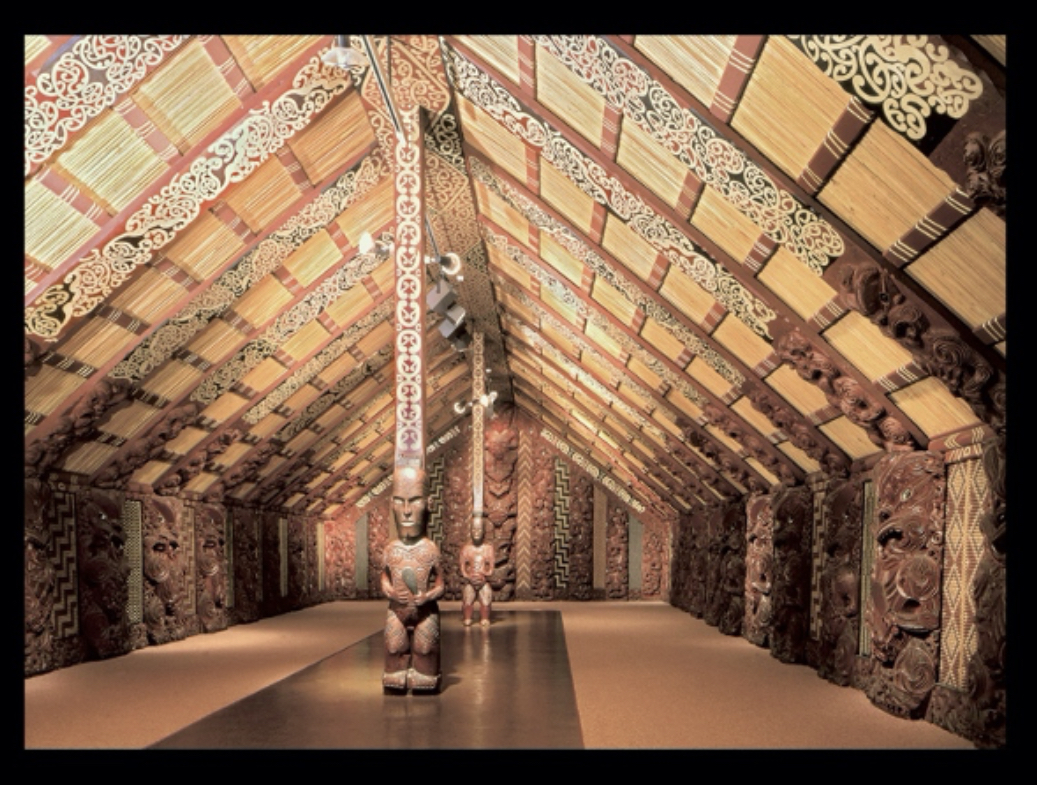
\-Te-Hau-Ki-Puranga (Māori Meeting House)
\-Raharuhi Rukupo
\-Location; New Zealand
\-1842- 1843
\-Wood, shell, glass, flax & pigments
\-Te-Hau-ki-Turanga is the oldest existing, fully decorated meeting house in New Zealand
\-It was a memorial for master carver Raharuhi Rukupo's brother
\-The house symbolizes the tribe's founding ancestor, with a ridgepole for a background and enfolding arms; ancestors "support" the house
\-Curvilinear patterns, **kowhaiwhai**, decorate the rafters and lattice panels (**tukutuku**) made by women fill the spaces between wall planks
\-Sculptural figures are rendered frontally and have large heads with open eyes
\-Raharuhi Rukupo
\-Location; New Zealand
\-1842- 1843
\-Wood, shell, glass, flax & pigments
\-Te-Hau-ki-Turanga is the oldest existing, fully decorated meeting house in New Zealand
\-It was a memorial for master carver Raharuhi Rukupo's brother
\-The house symbolizes the tribe's founding ancestor, with a ridgepole for a background and enfolding arms; ancestors "support" the house
\-Curvilinear patterns, **kowhaiwhai**, decorate the rafters and lattice panels (**tukutuku**) made by women fill the spaces between wall planks
\-Sculptural figures are rendered frontally and have large heads with open eyes
3
New cards
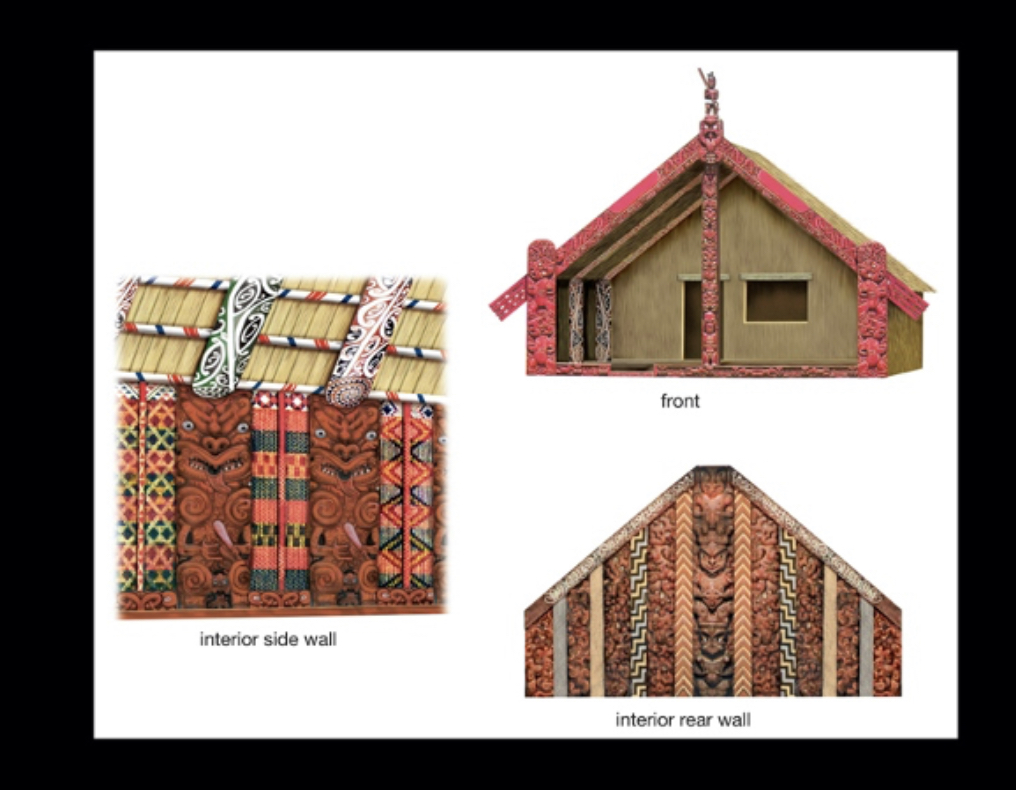
\-Part of the Meeting House
4
New cards
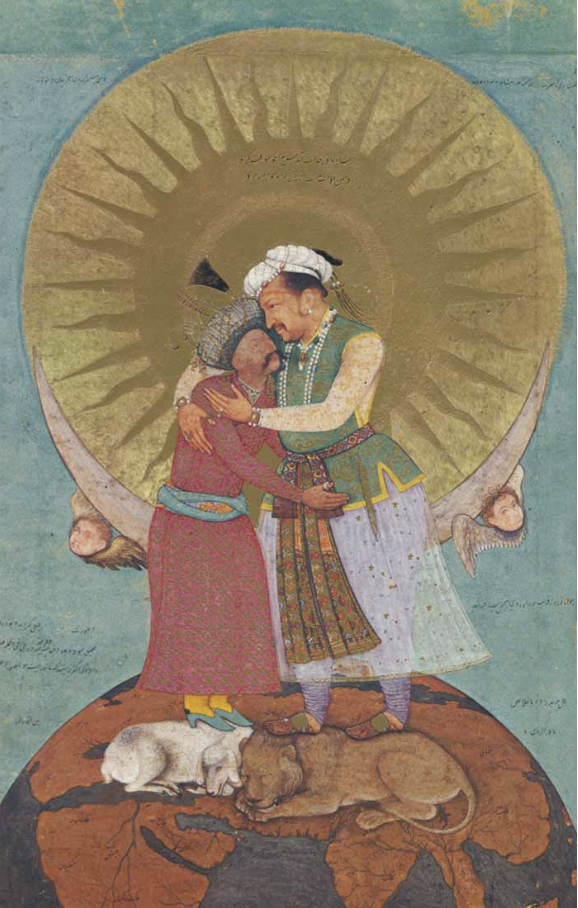
\
\-Jahangir & Shah Abbas
\-Nadir al-Zaman (Abu’l Hasan)
\-Location; India
\-Mughal Period, 1618
\-Opaque watercolour, gold & ink on paper
\-Jahangir, successor to Akbar, established his own workshop for painting
\-Portraiture became prolific at this time
\-A painting of Jahangir and Shah Abbas was created during a moment of tension between Shah Abbas and the Mughal throne
\-Jahangir is depicted as much larger than Shah Abbas, who bows deferentially to the emperor
\-Nadir al-Zaman (Abu’l Hasan)
\-Location; India
\-Mughal Period, 1618
\-Opaque watercolour, gold & ink on paper
\-Jahangir, successor to Akbar, established his own workshop for painting
\-Portraiture became prolific at this time
\-A painting of Jahangir and Shah Abbas was created during a moment of tension between Shah Abbas and the Mughal throne
\-Jahangir is depicted as much larger than Shah Abbas, who bows deferentially to the emperor
5
New cards
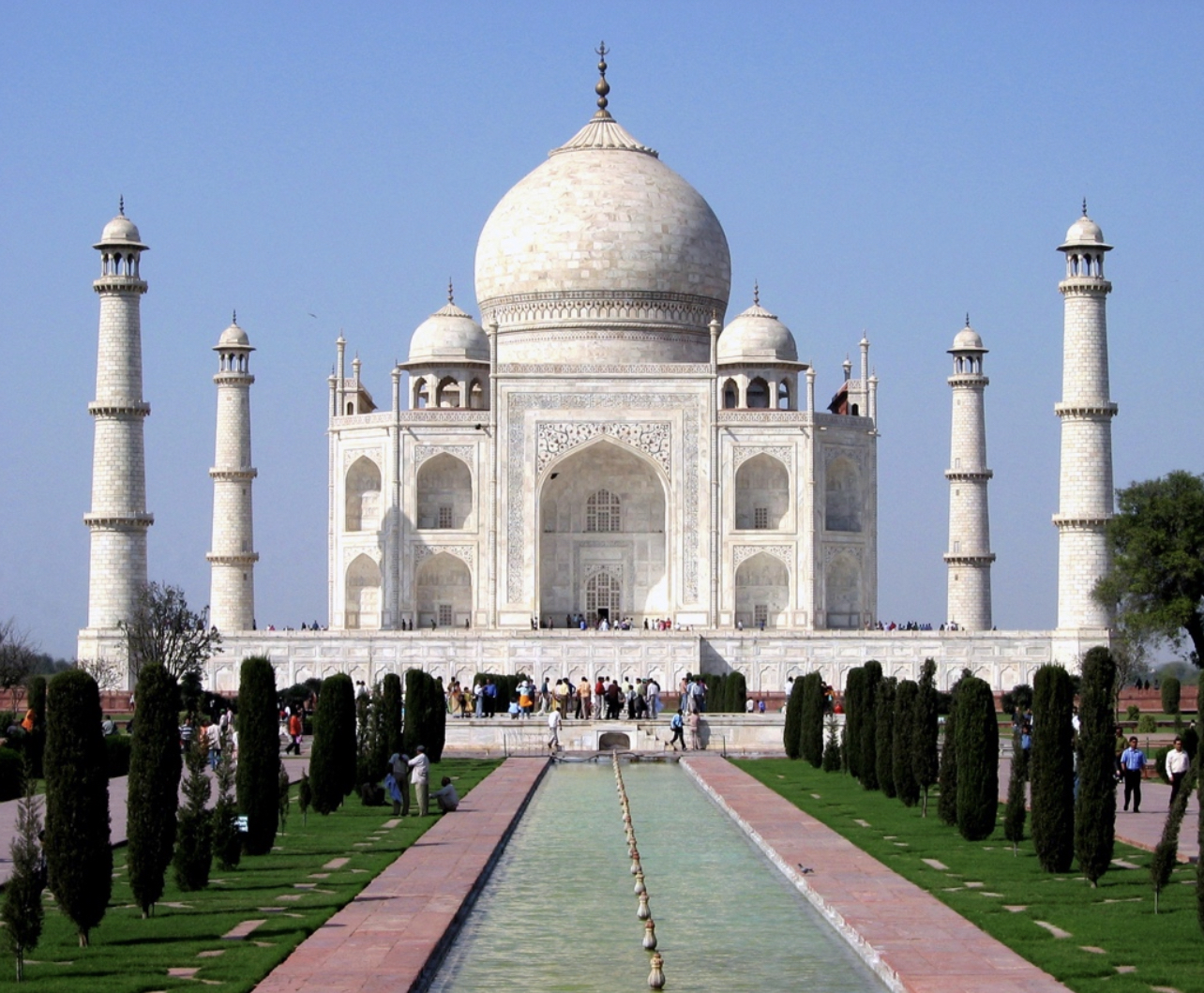
\-Taj Mahal
\-Shah Jahan
\-Location; Agra, India
\-Mughal Period, 1631 - 1648
\-Brick, sandstone, white marble
\-Shah Jahan built this mausoleum in honor of his wife, Mumtaz Mahal
\-It was the first major architectural undertaking during his reign
\-The enclosure is divided into quadrants, which would have had fruit trees and cypresses in Shah Jahan's time
\-The garden would have continued on the far bank of the Jamuna River
\-The tomb was flanked by a mosque and a hall on either side
\-A **chattri** crowns each minaret
\-Although it is basically square, **chamfered** corners create a subtle octagon
\-Surfaces are embellished with subtle relief and a **blind** **arcade** motif
\-Shah Jahan
\-Location; Agra, India
\-Mughal Period, 1631 - 1648
\-Brick, sandstone, white marble
\-Shah Jahan built this mausoleum in honor of his wife, Mumtaz Mahal
\-It was the first major architectural undertaking during his reign
\-The enclosure is divided into quadrants, which would have had fruit trees and cypresses in Shah Jahan's time
\-The garden would have continued on the far bank of the Jamuna River
\-The tomb was flanked by a mosque and a hall on either side
\-A **chattri** crowns each minaret
\-Although it is basically square, **chamfered** corners create a subtle octagon
\-Surfaces are embellished with subtle relief and a **blind** **arcade** motif
6
New cards
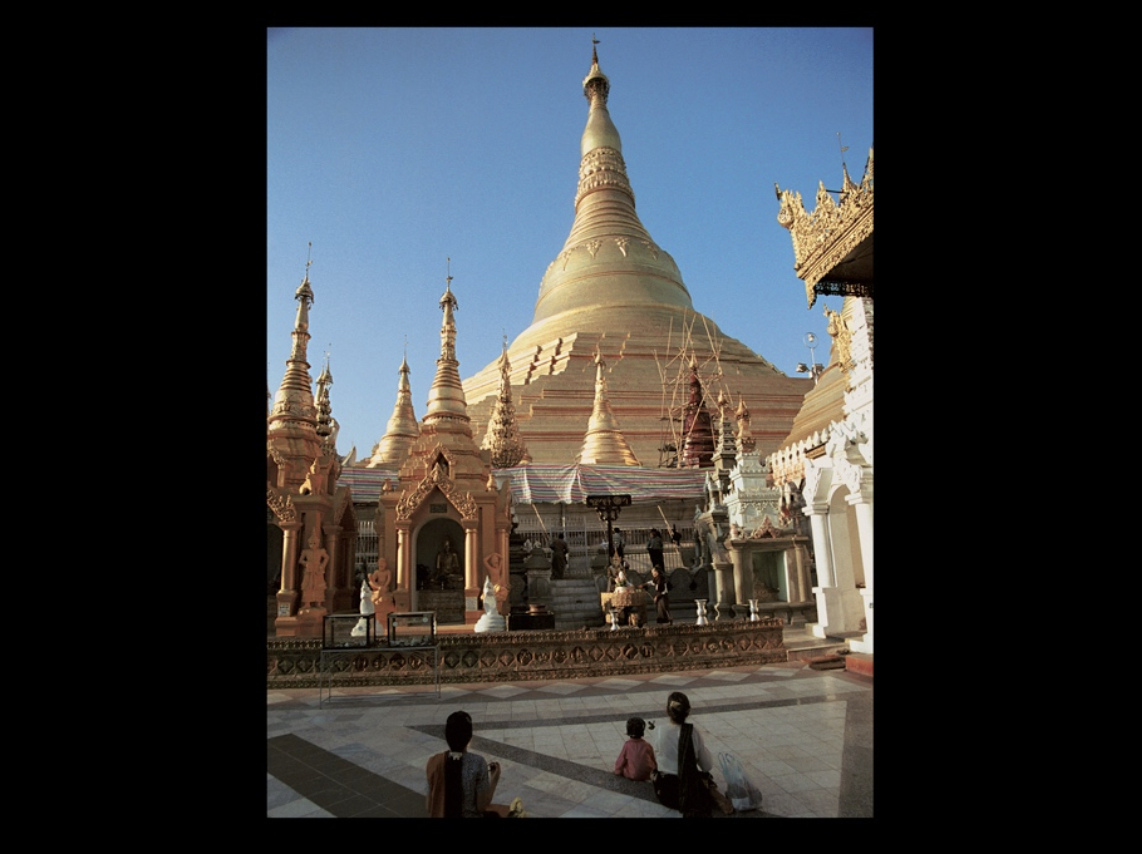
\-Shwedagon Stupa (Pagoda)
\-Artist Unknown, built under Burmese rulers
\-Location; Yangon, Myanmar
\-14th - 15th century
\-Made of bricks covered with genuine gold plates and the main stupa itself is entirely covered in gold, adorned with a crowning umbrella encrusted with diamonds and other jewels
\-The port city of Yangon is the site for this stupa, which enshrines relics of the four past Buddhas
\-It underwent continual restoration and enhancement under Burmese rulers
\-The bell-shaped spire is capped by an umbrellalike shape
\-Artist Unknown, built under Burmese rulers
\-Location; Yangon, Myanmar
\-14th - 15th century
\-Made of bricks covered with genuine gold plates and the main stupa itself is entirely covered in gold, adorned with a crowning umbrella encrusted with diamonds and other jewels
\-The port city of Yangon is the site for this stupa, which enshrines relics of the four past Buddhas
\-It underwent continual restoration and enhancement under Burmese rulers
\-The bell-shaped spire is capped by an umbrellalike shape
7
New cards
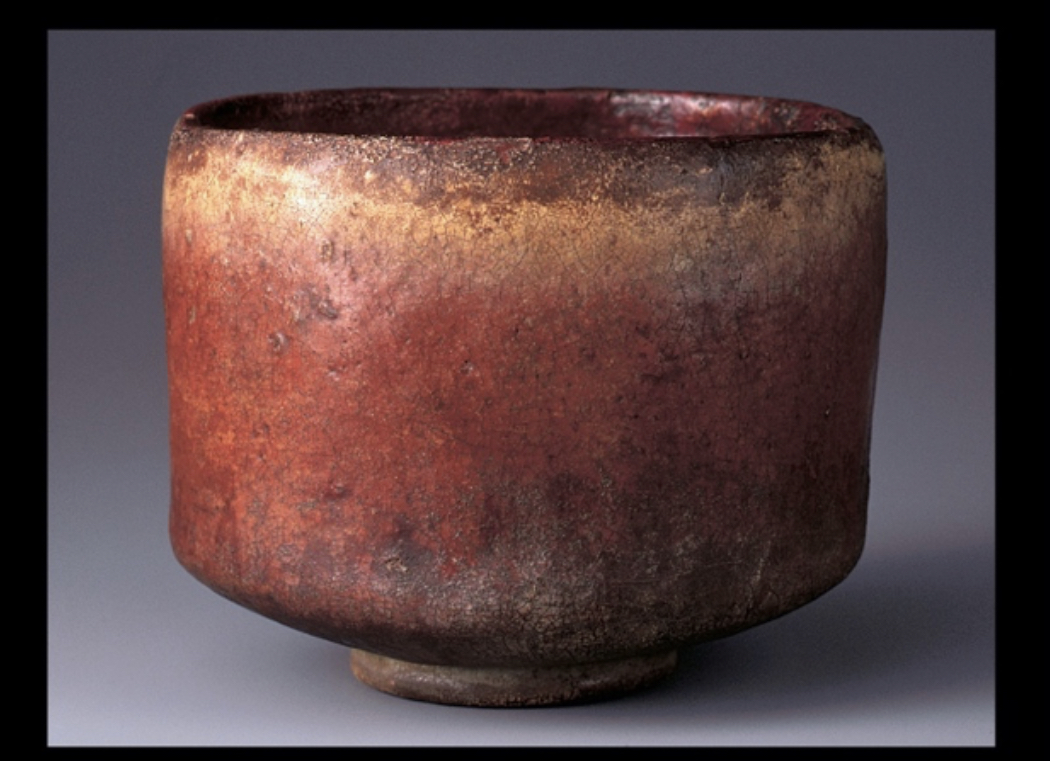
\-Tea Bowl, called Yugure (“Twilight”)
\-Chojiro
\-Location; Kyoto
\-Momoyama Period, late 16th century
\-Raku Ware
\-Slightly misshapen Korean-style rice bowls became inspiration for potters
\-One of the finest surviving early tea bowls is *Yugure*, attributed to Chojiro, founder of the Raku potter
\-The gritty red clay of **raku** ware was developed specifically for the tea ceremony.
\-Chojiro
\-Location; Kyoto
\-Momoyama Period, late 16th century
\-Raku Ware
\-Slightly misshapen Korean-style rice bowls became inspiration for potters
\-One of the finest surviving early tea bowls is *Yugure*, attributed to Chojiro, founder of the Raku potter
\-The gritty red clay of **raku** ware was developed specifically for the tea ceremony.
8
New cards
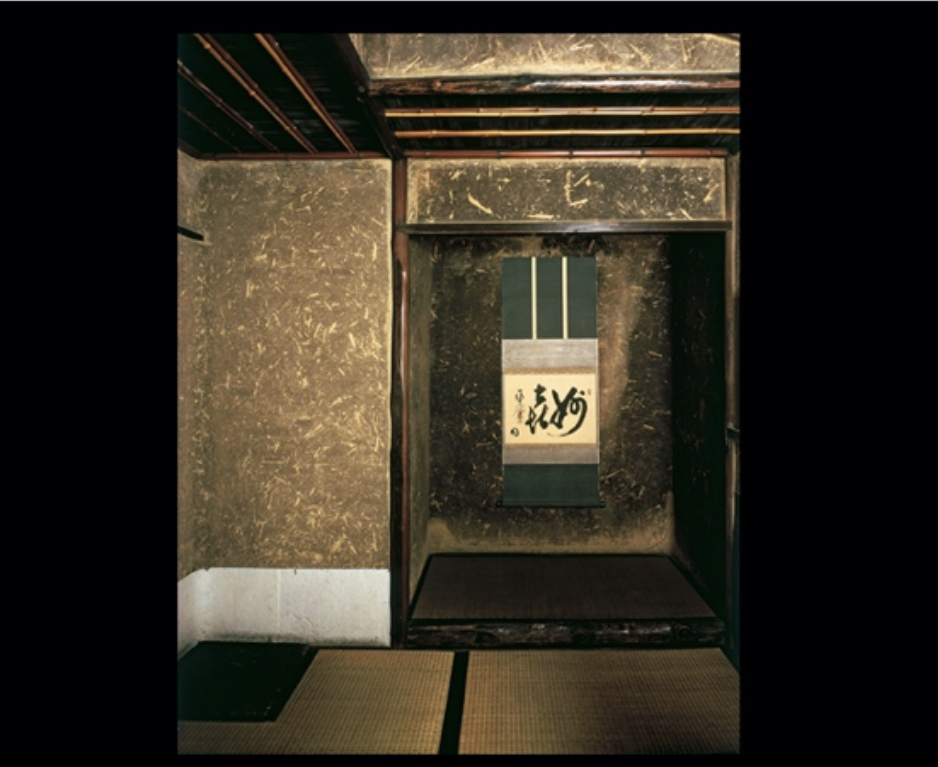
\-Taian Tearoom
\-Sen no Rikyu
\-Location; Kyoto
\-Momoyama Period, 1582
\-Wood, bamboo
\-The most famous tea master in Japanese history, Sen no Rikyu established the aesthetic of modesty, refinement, and rusticity in tearooms
\-The Taian is a tearoom that preserves his design
\-Guests must crawl to enter the room and no elements of distraction exist within
\-Sen no Rikyu
\-Location; Kyoto
\-Momoyama Period, 1582
\-Wood, bamboo
\-The most famous tea master in Japanese history, Sen no Rikyu established the aesthetic of modesty, refinement, and rusticity in tearooms
\-The Taian is a tearoom that preserves his design
\-Guests must crawl to enter the room and no elements of distraction exist within
9
New cards
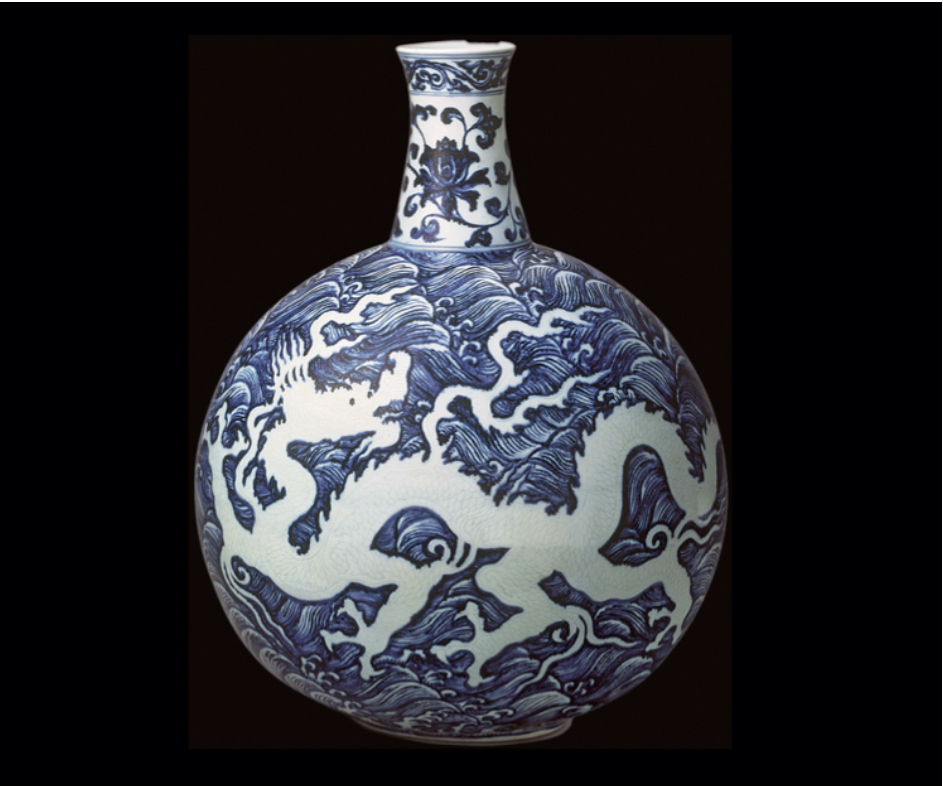
\-Pair of Flasks (Negative one)
\-Artist Unknown
\-Location; China
\-Ming Dynasty, 1403 - 1424 (reign of Yongle emperor)
\-Porcelain with decoration painted in underglaze cobalt blue
\-Imperial kilns in Jingdezhen became the most world-renowned center for porcelain
\-Subtle shape, vigorous decoration, and flawless glazing of the *flasks* on the next slide represent the achievements of Ming ceramic artists
\-Artist Unknown
\-Location; China
\-Ming Dynasty, 1403 - 1424 (reign of Yongle emperor)
\-Porcelain with decoration painted in underglaze cobalt blue
\-Imperial kilns in Jingdezhen became the most world-renowned center for porcelain
\-Subtle shape, vigorous decoration, and flawless glazing of the *flasks* on the next slide represent the achievements of Ming ceramic artists
10
New cards
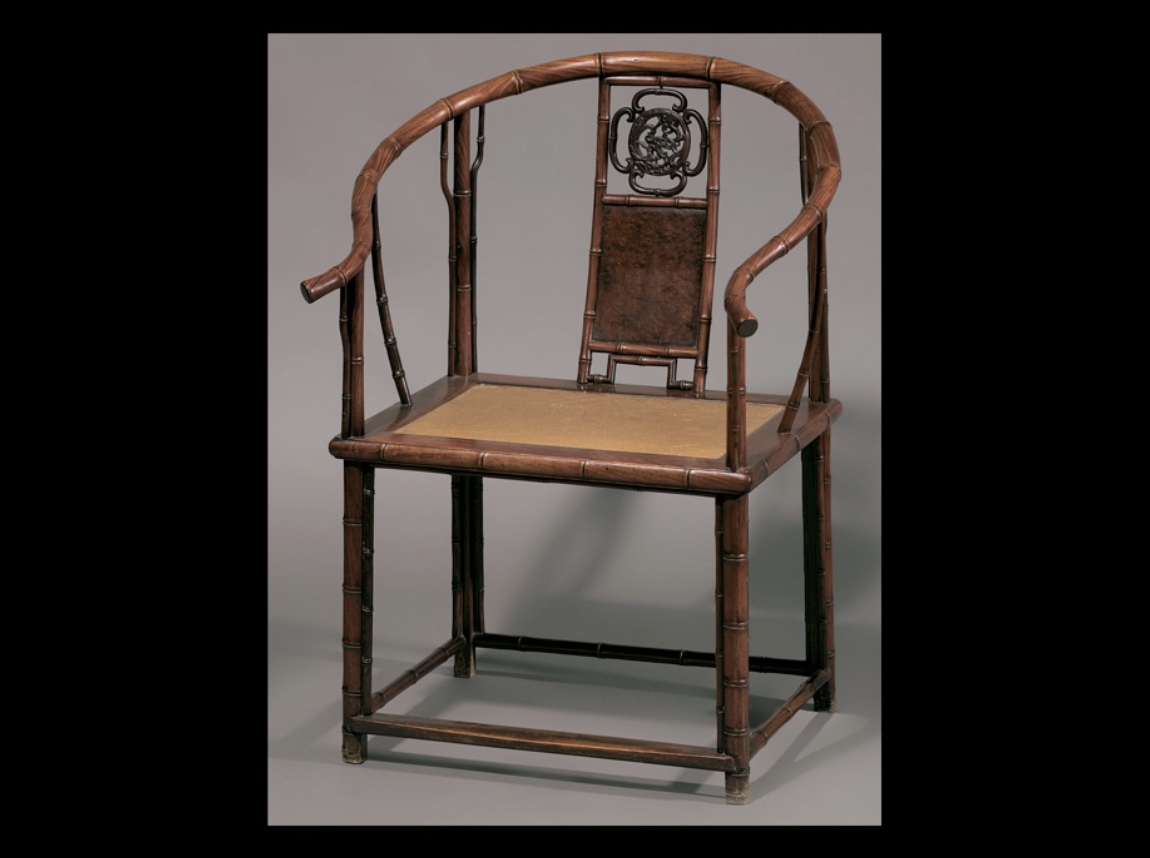
\-Arm Chair
\-Artist Unknown
\-Location; China
\-Ming Dynasty, 16th -17th century
\-Huanghuali wood (hardwood)
\-This chair is a result of the influence of the Literati Aesthetic
\-The *armchair* shown is constructed without glue or nails and emits a simple, clear, symmetrical, and balanced style
\-Landscape gardening flourished, evident in the largest surviving example, Garden of the Cessation of Official Life, which featured strings of pavilions with poetic names
\-Artist Unknown
\-Location; China
\-Ming Dynasty, 16th -17th century
\-Huanghuali wood (hardwood)
\-This chair is a result of the influence of the Literati Aesthetic
\-The *armchair* shown is constructed without glue or nails and emits a simple, clear, symmetrical, and balanced style
\-Landscape gardening flourished, evident in the largest surviving example, Garden of the Cessation of Official Life, which featured strings of pavilions with poetic names
11
New cards
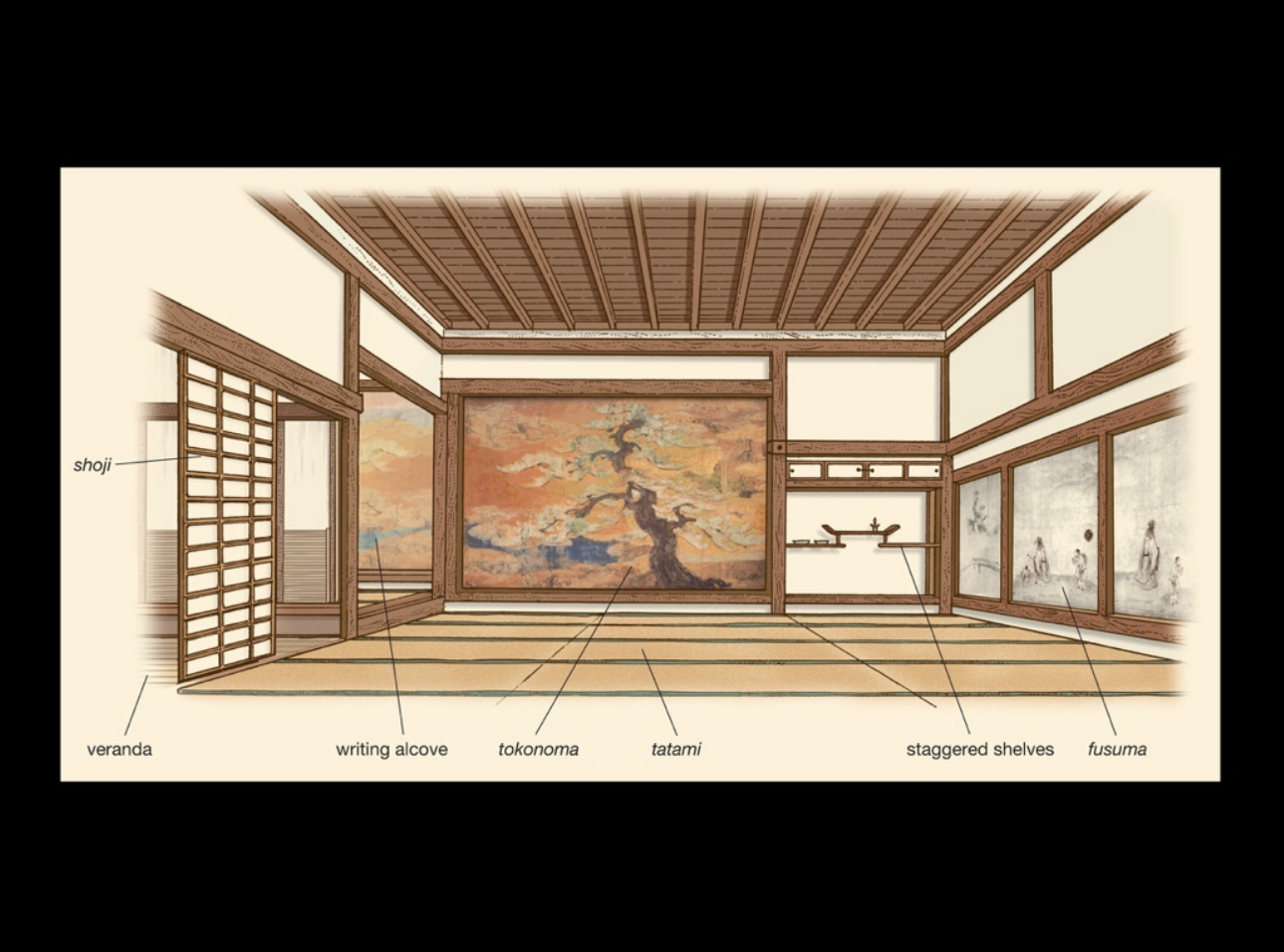
\-Artist’s Rendering of the Kojoin Guesthouse at Onojoji
12
New cards
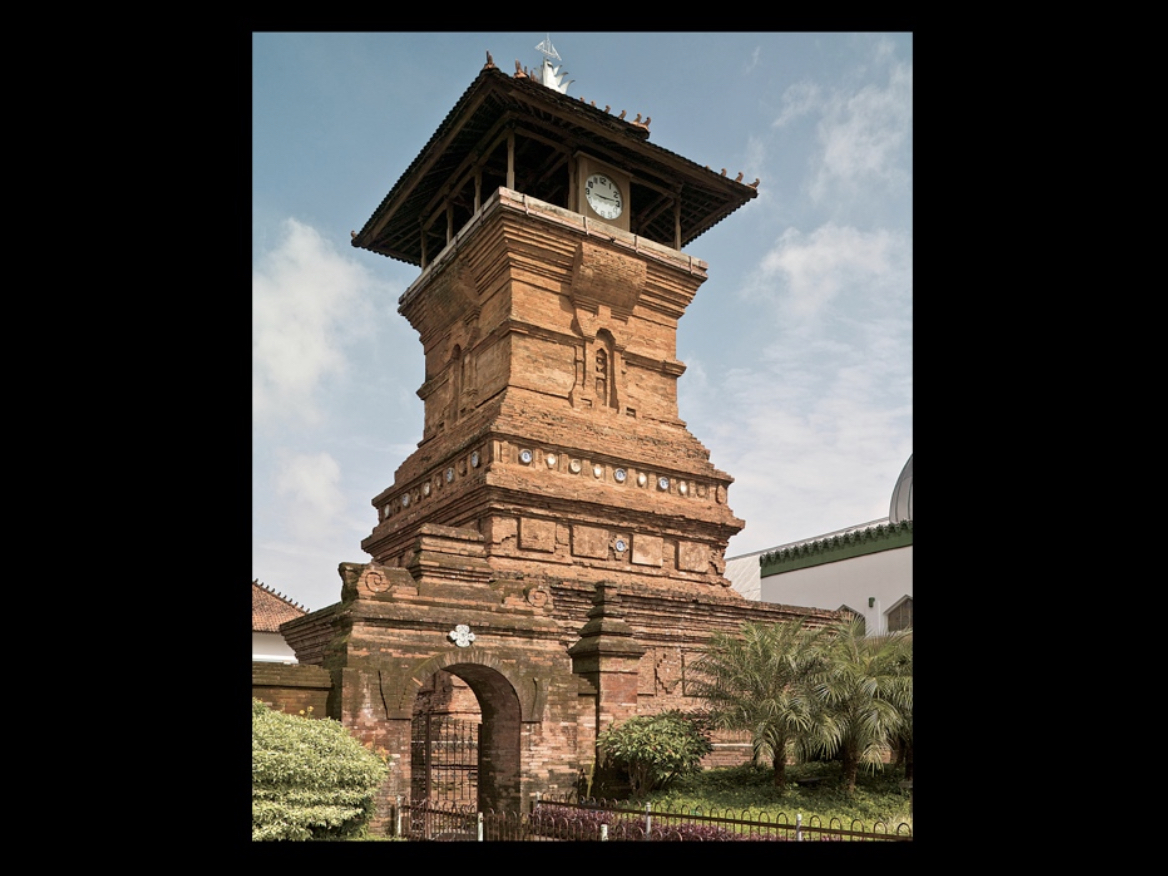
\-Minaret, Kudus Mosque
\-Artist Unknown
\-Location; Kudus, Java, Indonesia
\-1549
\-Red Brickwork
\-This is one of the earliest examples of Islamic architecture in Java; while the mosque itself was renovated, the minaret survives from 1549
\-Various indigenous and international influences shaped this tower
\-Artist Unknown
\-Location; Kudus, Java, Indonesia
\-1549
\-Red Brickwork
\-This is one of the earliest examples of Islamic architecture in Java; while the mosque itself was renovated, the minaret survives from 1549
\-Various indigenous and international influences shaped this tower
13
New cards

\-Gateway of India
\-George Wittet
\-Location; Mumbai, India
\-1924
\-Yellow Basalt
\-Built to welcome King George V, the British constructed this monument in the style of a European triumphal arch and decorated it with South Asian embellishments
\-The Gateway was later used as a symbolic ceremonial entrance to India for Viceroys and the new Governors of Bombay
\-The Gateway of India has stood at the port of Mumbai for over 90 years
\-The arched monument stands 85 ft high on Mumbai Harbor, overlooking the Arabian Sea
\-George Wittet
\-Location; Mumbai, India
\-1924
\-Yellow Basalt
\-Built to welcome King George V, the British constructed this monument in the style of a European triumphal arch and decorated it with South Asian embellishments
\-The Gateway was later used as a symbolic ceremonial entrance to India for Viceroys and the new Governors of Bombay
\-The Gateway of India has stood at the port of Mumbai for over 90 years
\-The arched monument stands 85 ft high on Mumbai Harbor, overlooking the Arabian Sea
14
New cards
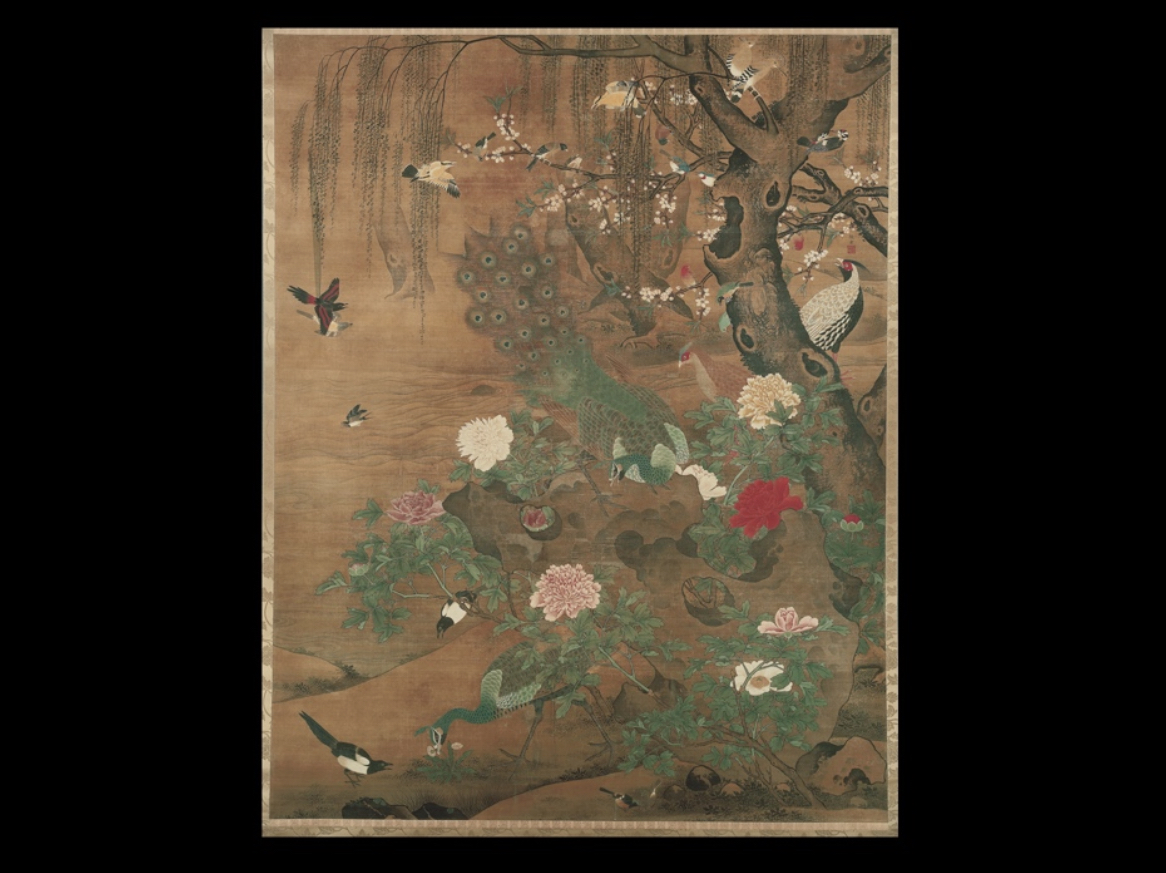
\-Hundreds of Birds admiring the Peacocks
\-Yin Hong
\-Location; China
\-Ming Dynasty, late 15th - early 16th century
\-Hanging scroll with ink & colour on silk
\-An example of Ming court taste is typified in *Hundreds of Birds Admiring the Peacocks* by Yin Hong
\-The subject symbolizes homage of court officials to the imperial state
\-A bolder and less constrained landscape style, sometimes called the Zhe, is represented in *Returning Home Late from a Spring Outing*
\-Yin Hong
\-Location; China
\-Ming Dynasty, late 15th - early 16th century
\-Hanging scroll with ink & colour on silk
\-An example of Ming court taste is typified in *Hundreds of Birds Admiring the Peacocks* by Yin Hong
\-The subject symbolizes homage of court officials to the imperial state
\-A bolder and less constrained landscape style, sometimes called the Zhe, is represented in *Returning Home Late from a Spring Outing*
15
New cards
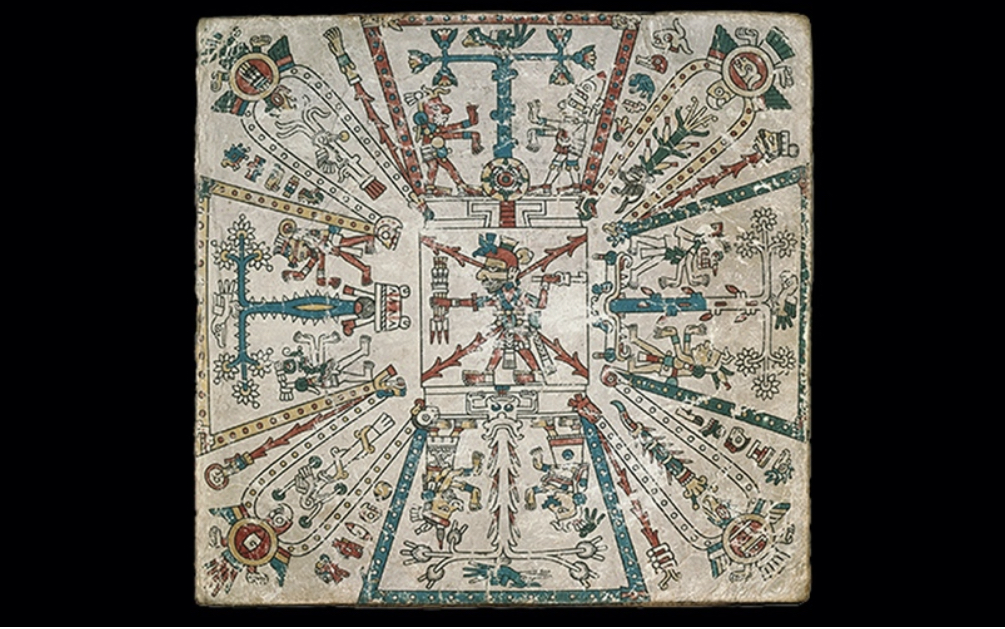
\-A view of the world
\-Artist Unknown
\-Location; Mexico
\-1400 - 1519
\-Paint on animal hide
\-Page from Codex Fejervary-Mayer
\-Books took the form of a screen-fold that allowed different pages of the book to be juxtaposed
\-A rare manuscript preserved Mesoamerican cosmology
\-Each of the 260 dots refers to a day in their calendar, and they were linked to 20 day signs throughout the image
\-Artist Unknown
\-Location; Mexico
\-1400 - 1519
\-Paint on animal hide
\-Page from Codex Fejervary-Mayer
\-Books took the form of a screen-fold that allowed different pages of the book to be juxtaposed
\-A rare manuscript preserved Mesoamerican cosmology
\-Each of the 260 dots refers to a day in their calendar, and they were linked to 20 day signs throughout the image
16
New cards
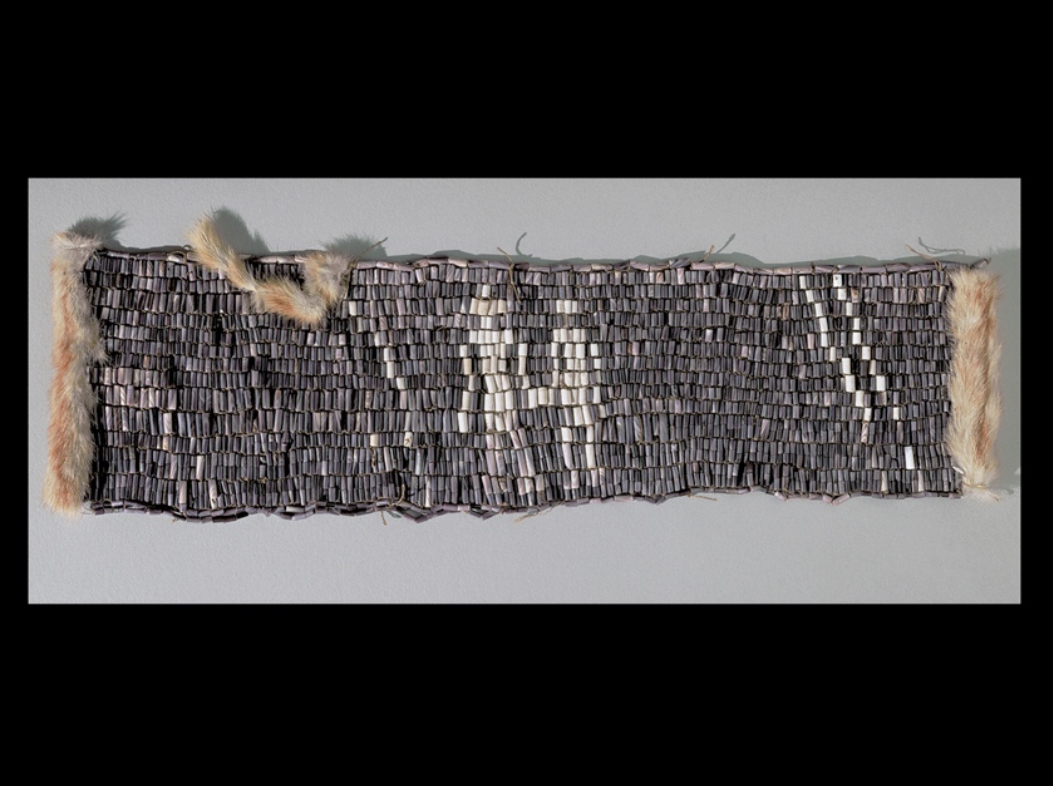
\-Wampum Belt
\-Artist Unknown
\-Location; The Eastern Woodlands, North America
\-1680’s
\-Shell beads, fur
\-Belts and strings of purple and white shell beads were called wampum
\-These were exchanged to keep records and conclude treaties
\-Few survive, but the one on the next slide commemorates a treaty of Pennsylvania land being ceded by the Delawares in 1682
\-Traditionally called William Penn’s Treaty with The Delaware
\-Artist Unknown
\-Location; The Eastern Woodlands, North America
\-1680’s
\-Shell beads, fur
\-Belts and strings of purple and white shell beads were called wampum
\-These were exchanged to keep records and conclude treaties
\-Few survive, but the one on the next slide commemorates a treaty of Pennsylvania land being ceded by the Delawares in 1682
\-Traditionally called William Penn’s Treaty with The Delaware
17
New cards
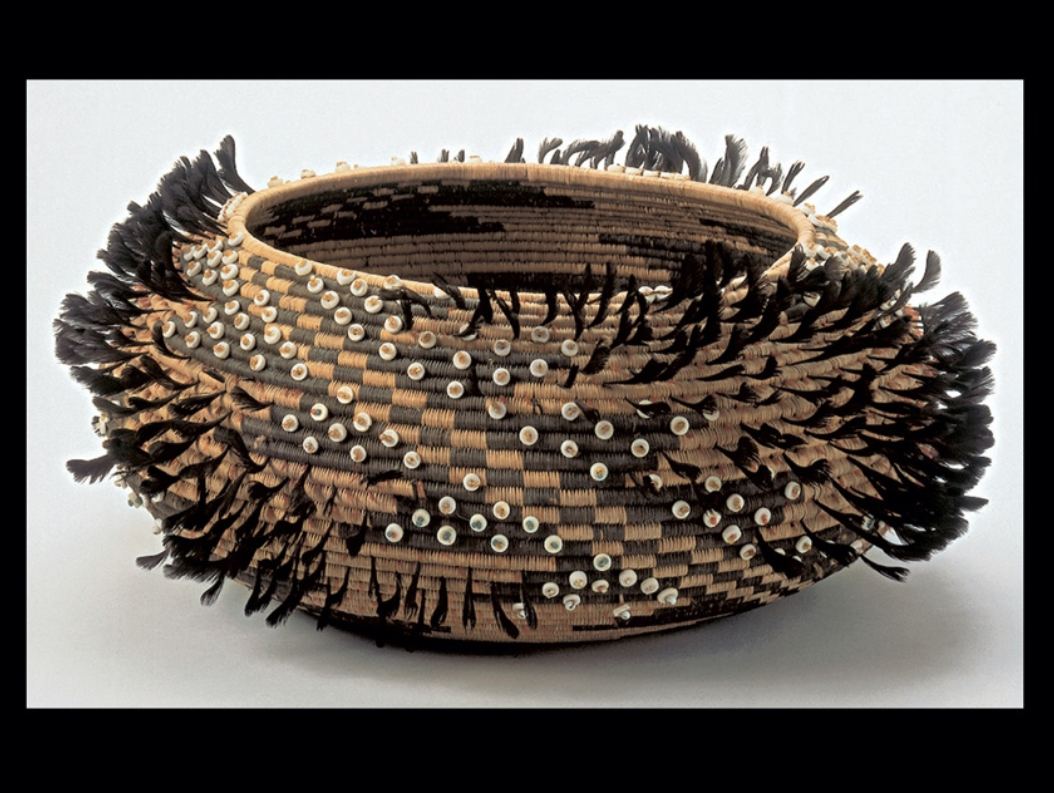
\-Feathered Basket
\-A Pomo Woman from California
\-Location; California, U.S.
\-1877
\-Willow, bulrush, fern, feather, shells, glass beads
\-Three principal basket-making techniques include coiling, twining, and plaiting
\-It features a spiral surface with clam shell and feathers woven into it
\-Such baskets were treasured and even cremated with their owners at death.
\-A Pomo Woman from California
\-Location; California, U.S.
\-1877
\-Willow, bulrush, fern, feather, shells, glass beads
\-Three principal basket-making techniques include coiling, twining, and plaiting
\-It features a spiral surface with clam shell and feathers woven into it
\-Such baskets were treasured and even cremated with their owners at death.
18
New cards
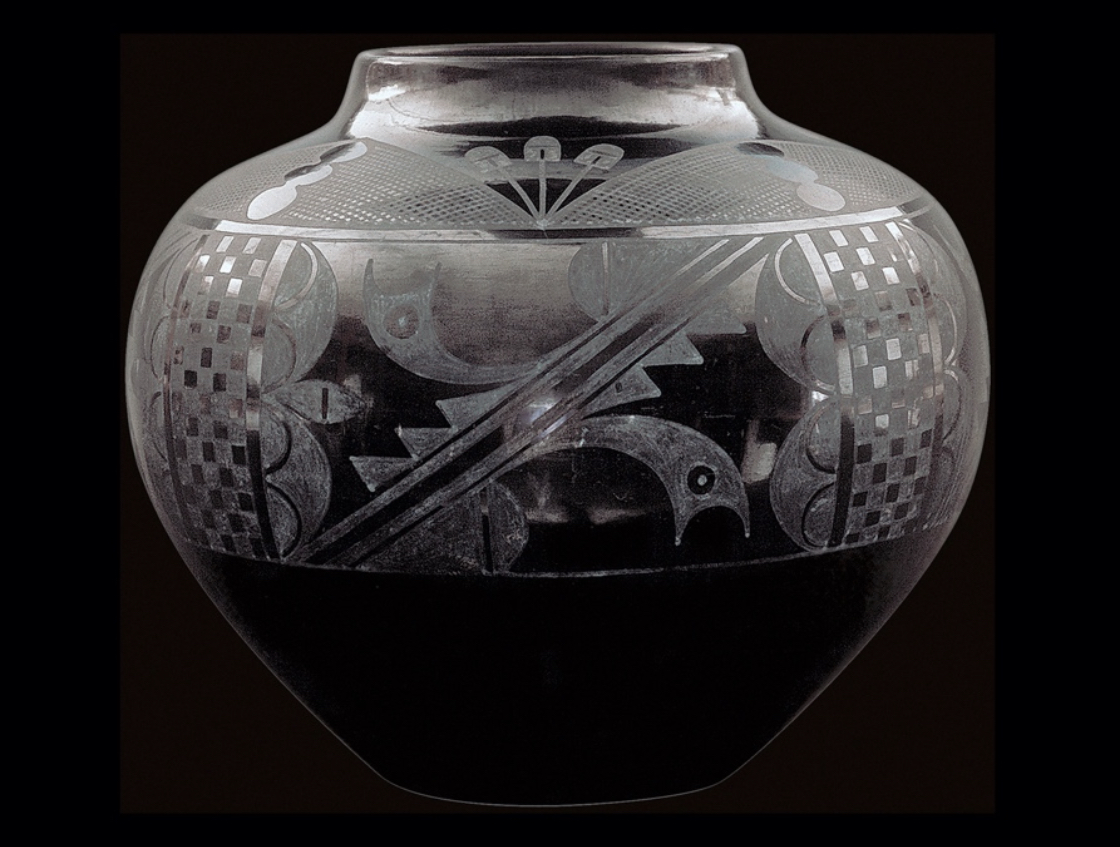
\-Black-on-black storage jar
\-Maria Montoya Martinez & Julian Martinez
\-Location; New Mexico
\-1942
\-Ceramic
\-The contemporary Pueblo people still make fine ceramics
\-Maria Montoya Martinez of the San Ildefonso Pueblo created a unique **blackware** style noted for its elegant forms and subtle textures
\-Maria Montoya Martinez & Julian Martinez
\-Location; New Mexico
\-1942
\-Ceramic
\-The contemporary Pueblo people still make fine ceramics
\-Maria Montoya Martinez of the San Ildefonso Pueblo created a unique **blackware** style noted for its elegant forms and subtle textures
19
New cards
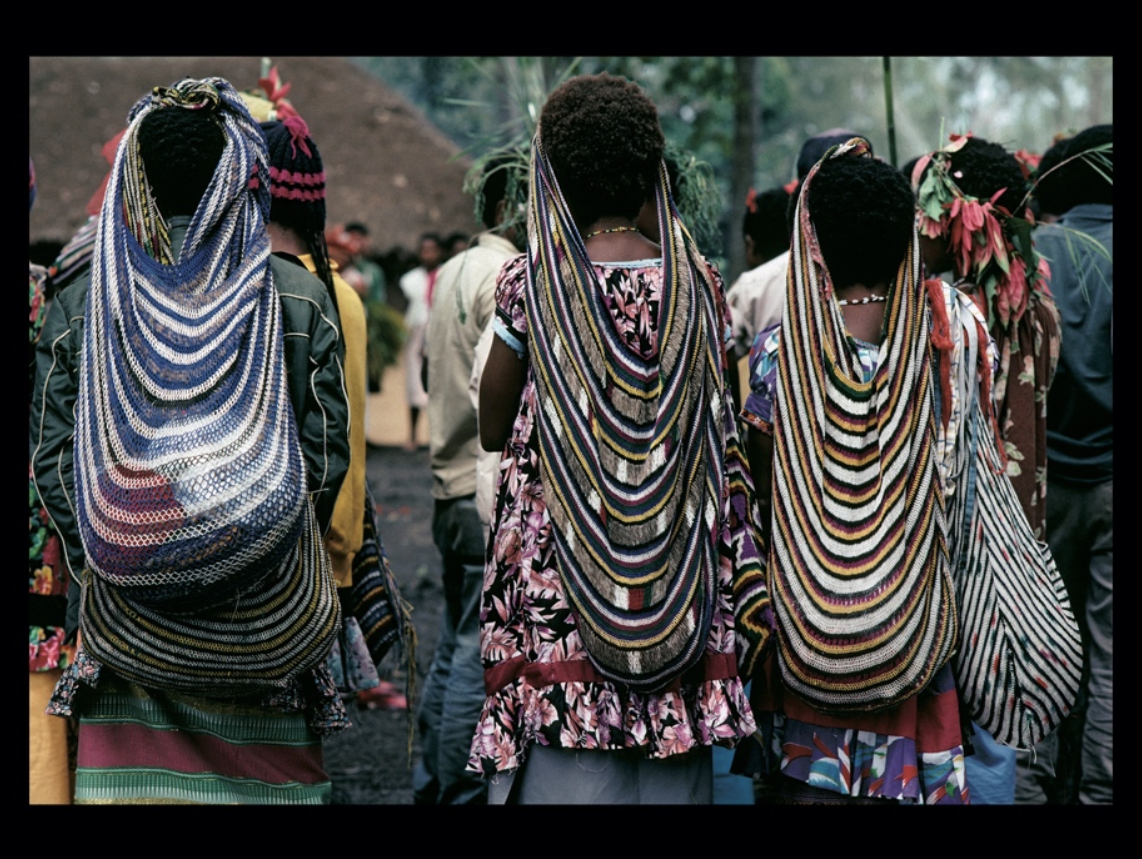
\-Women wearing Net Bags (Bilum)
\-Artist Unknown
\-Location; Wahgi Valley, Papua New Guinea
\-1990
\-Fibre
\-*Bilum* are rich metaphorical symbols, even synonyms for *womb* and *bride* among women of the Waghi tribe
\-They can carry items from vegetables to babies to bones of the deceased
\-Contemporary fibers have made their way into the complicated patterns
\-Artist Unknown
\-Location; Wahgi Valley, Papua New Guinea
\-1990
\-Fibre
\-*Bilum* are rich metaphorical symbols, even synonyms for *womb* and *bride* among women of the Waghi tribe
\-They can carry items from vegetables to babies to bones of the deceased
\-Contemporary fibers have made their way into the complicated patterns
20
New cards

\-Royal Mortuary Compound
\-Nan Madol
\-Location; Pohnpei, Micronesia
\-1200
\-Basalt blocks
\-Nan Madol was an administrative and ceremonial center for powerful kings and consists of 92 artificial islands within a network of about 170 acres
\-Walls of the Royal Mortuary Compound rise to 25 tall
\-Stone logs were split from the cliffs by heating and dousing the stone in alternation
\-Nan Madol
\-Location; Pohnpei, Micronesia
\-1200
\-Basalt blocks
\-Nan Madol was an administrative and ceremonial center for powerful kings and consists of 92 artificial islands within a network of about 170 acres
\-Walls of the Royal Mortuary Compound rise to 25 tall
\-Stone logs were split from the cliffs by heating and dousing the stone in alternation
21
New cards
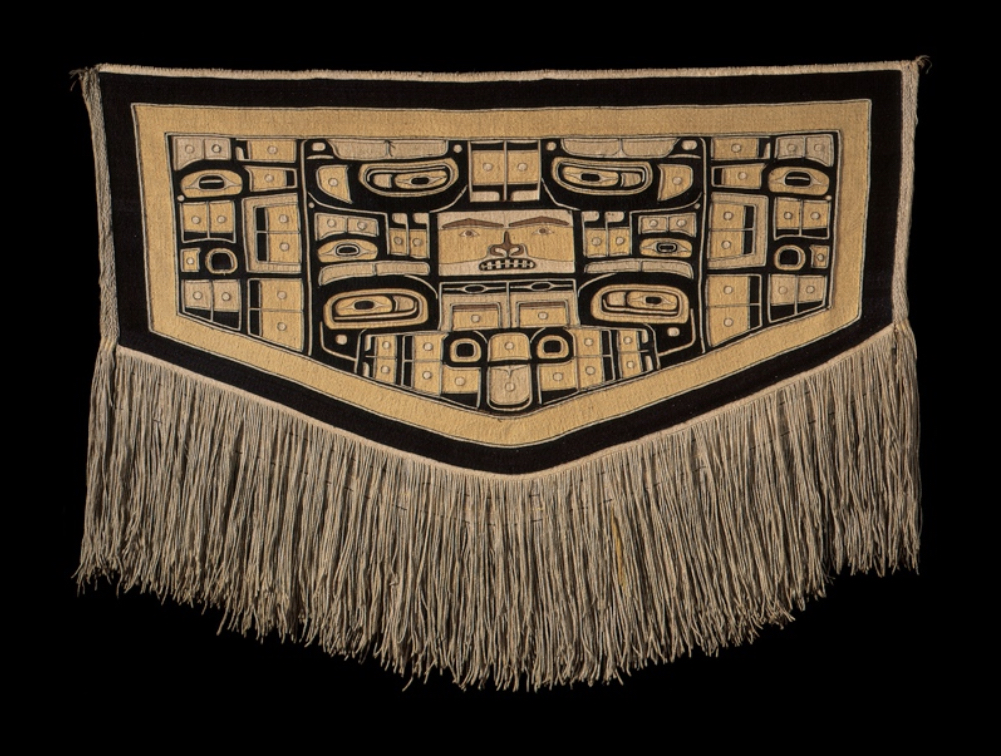
\-Chilkat Blanket
\-Chilkat Tlingit Men & Women
\-Location; Southeast Alaska, North America
\-1850
\-Mountain goat wool, yellow cedar bark, linen thread
\-Men drew patterns on boards, and women wove them into blankets
\-The popular design shown here is the diving whale; precise identifications and meanings have not been established
\-Ovoid and formline shapes are characteristic of Northwest painting
\-Chilkat Tlingit Men & Women
\-Location; Southeast Alaska, North America
\-1850
\-Mountain goat wool, yellow cedar bark, linen thread
\-Men drew patterns on boards, and women wove them into blankets
\-The popular design shown here is the diving whale; precise identifications and meanings have not been established
\-Ovoid and formline shapes are characteristic of Northwest painting
22
New cards
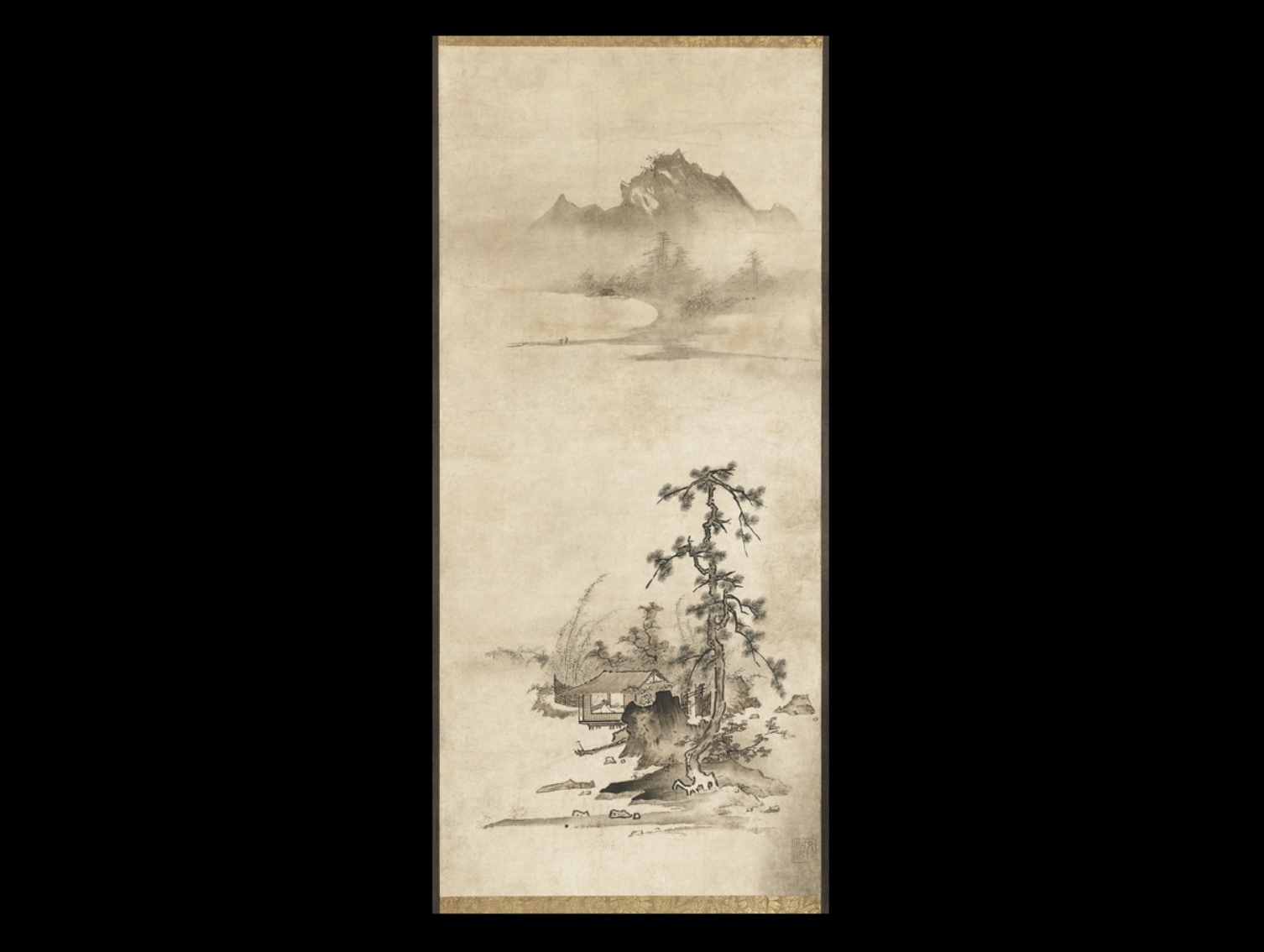
\-Bunsei Landscape
\-Shubun
\-Location; Japan
\-Muromachi period, mid 15th century
\-Hanging scroll with ink & light colours on paper
\-Many Japanese artists adopted monochrome landscape paintings during this period
\-No undisputed work survives of the monk-artist Shubun, but two by his pupil Bunsei remain
\-Mimicking Chinese models from the Ming period as well as Korean ink landscapes, works convey serenity
\-Shubun
\-Location; Japan
\-Muromachi period, mid 15th century
\-Hanging scroll with ink & light colours on paper
\-Many Japanese artists adopted monochrome landscape paintings during this period
\-No undisputed work survives of the monk-artist Shubun, but two by his pupil Bunsei remain
\-Mimicking Chinese models from the Ming period as well as Korean ink landscapes, works convey serenity
23
New cards
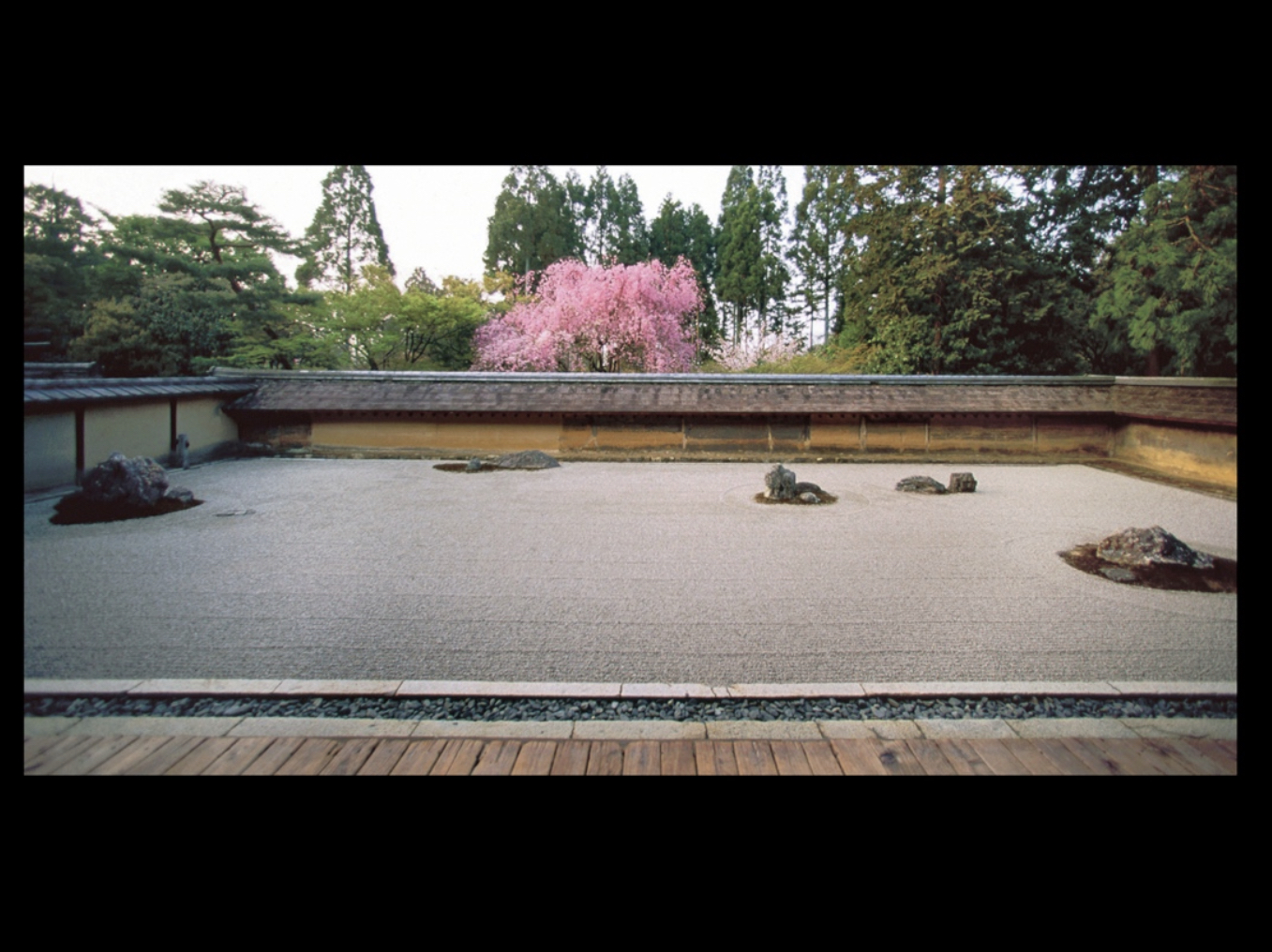
\-Dry Rock Garden
\-Artist Unknown
\-Location; Ryoanji, Kyoto
\-Muromachi Period, 1480
\-Rocks, gravel
\-Dry landscape gardens like the temple at Ryoanji present beautiful stones in asymmetrical arrangements across a flat rectangle of gravel
\-They were inspired by Chinese landscape paintings by the sixteenth century and became highly intellectualized by the mid-seventeenth century
\-Artist Unknown
\-Location; Ryoanji, Kyoto
\-Muromachi Period, 1480
\-Rocks, gravel
\-Dry landscape gardens like the temple at Ryoanji present beautiful stones in asymmetrical arrangements across a flat rectangle of gravel
\-They were inspired by Chinese landscape paintings by the sixteenth century and became highly intellectualized by the mid-seventeenth century
24
New cards
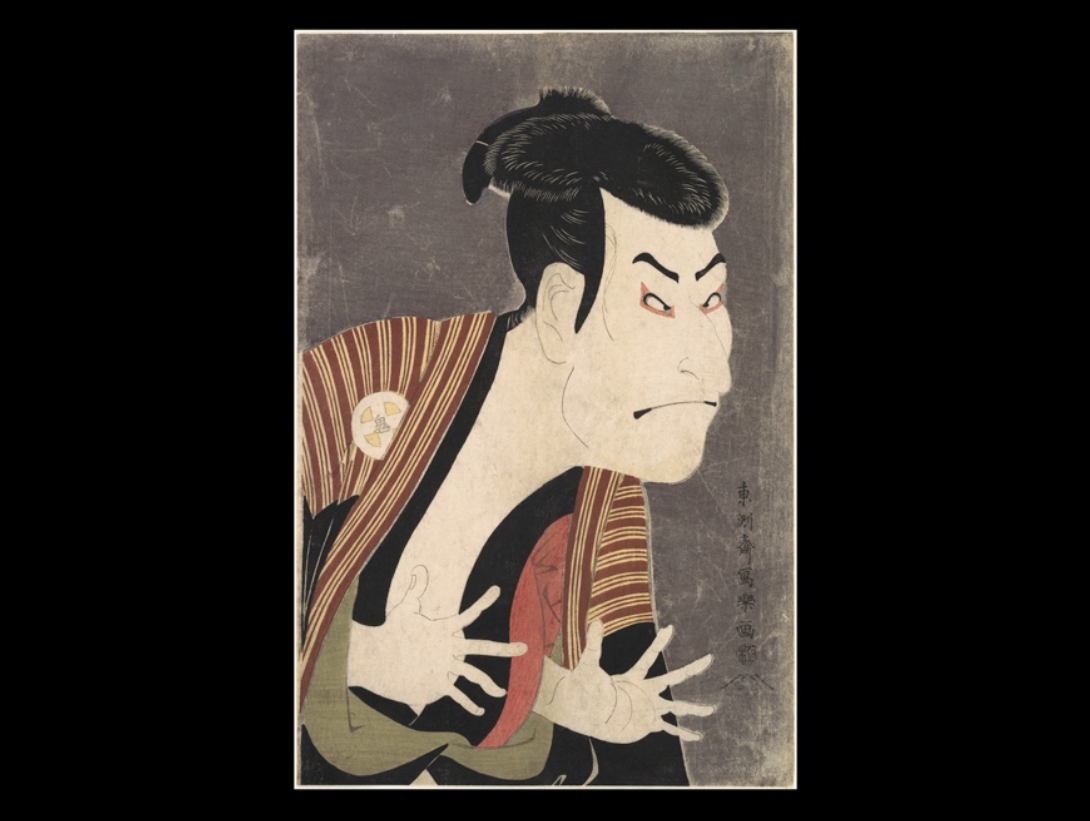
\-Otani Oniji in the role of Yakko Edobe
\-Toshusai Sharaku
\-Location; Edo
\-Edo Period, 1794
\-Polychrome woodblock print with ink, colours, & white mica on paper
\-Toshusai Sharaku produced 146 prints, mostly of famous kabuki actors, within the year of 1794–1795
\-*Otani Oniji* captures a tension-filled moment from an action drama
\-Such half-length portraits captured the essence of characters portrayed on stage
\-Toshusai Sharaku
\-Location; Edo
\-Edo Period, 1794
\-Polychrome woodblock print with ink, colours, & white mica on paper
\-Toshusai Sharaku produced 146 prints, mostly of famous kabuki actors, within the year of 1794–1795
\-*Otani Oniji* captures a tension-filled moment from an action drama
\-Such half-length portraits captured the essence of characters portrayed on stage
25
New cards
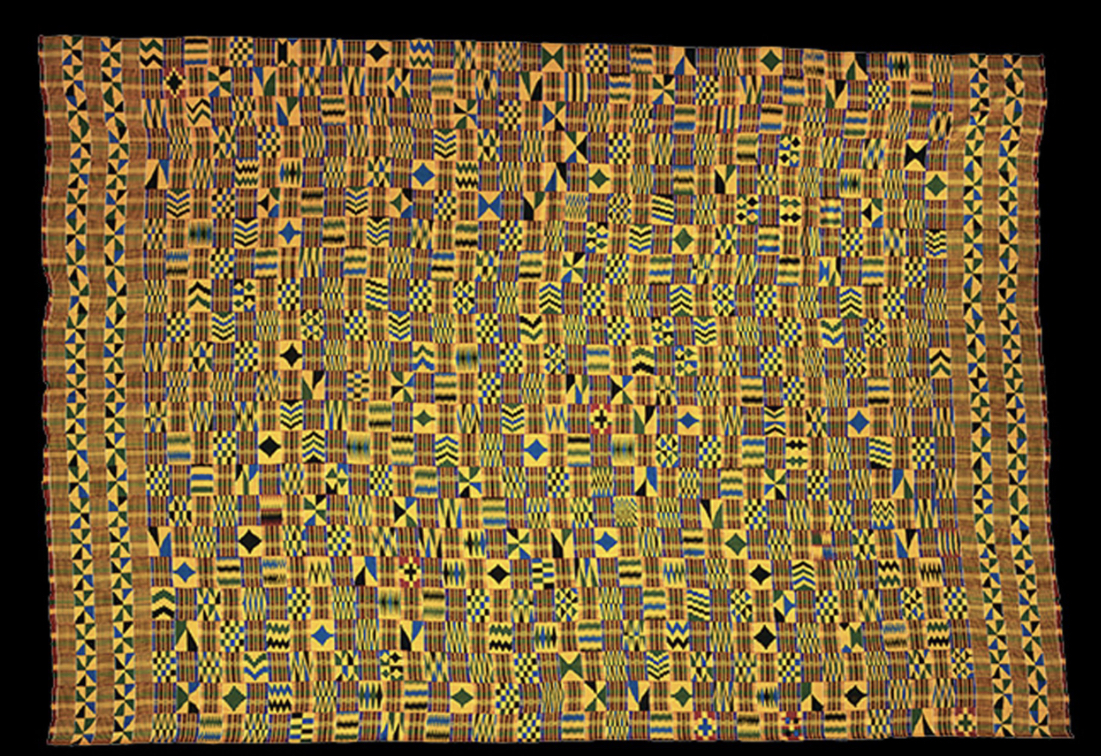
\-Kente Cloth
\-Rayon
\-Location; Asante, Ghana
\-1980
\-Cloth
\-Textile weavers used light, horizontal looms that appeared as rectangles on the finished kente cloth
\-Royal men wore a single piece while women wore a skirt and a shawl
\-The cloth is reserved for formal, special occasions
\-Rayon
\-Location; Asante, Ghana
\-1980
\-Cloth
\-Textile weavers used light, horizontal looms that appeared as rectangles on the finished kente cloth
\-Royal men wore a single piece while women wore a skirt and a shawl
\-The cloth is reserved for formal, special occasions
26
New cards
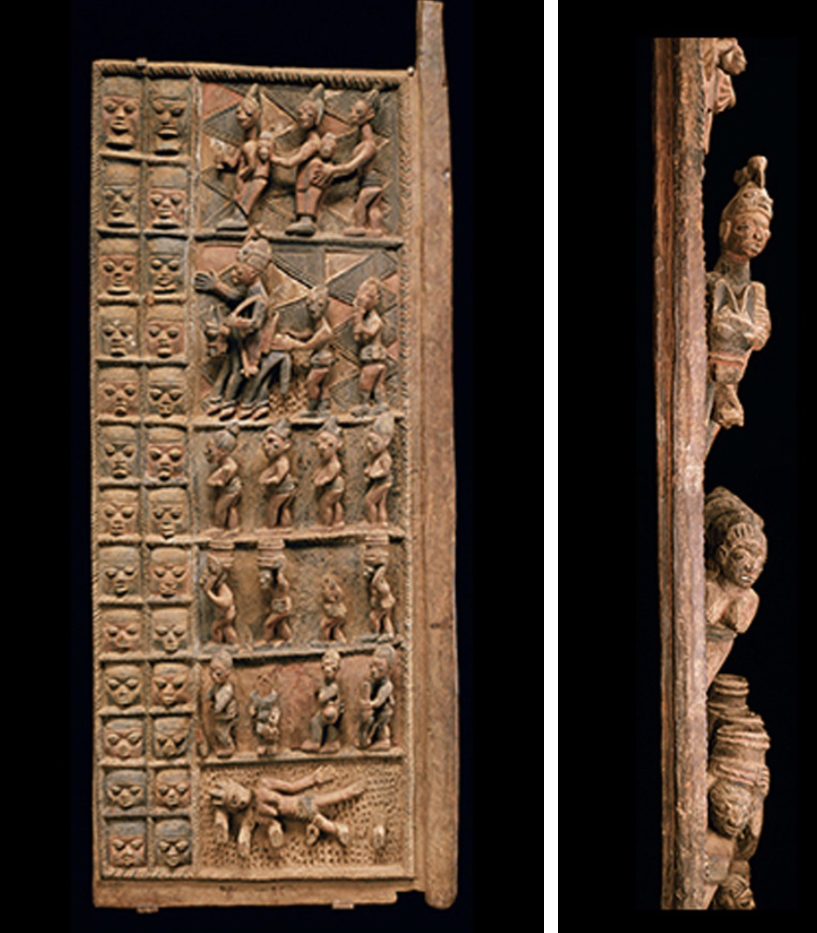
\-One of the two doors from the Kings Palace at Ise
\-Olowe of Ise
\-Location; Yoruba, Nigeria
\-1904 - 1910
\-Wood & Pigment
\-Olowe of Ise was one of the most important Yoruba artists of the early 20th century
\-He carved the door for the palace at Ise in an asymmetrical composition
\-The relief is so high that the figures’ upper bodies are carved in the round
\-It commemorates the arinjale’s reception of the first British travelling commissioner
\-Olowe of Ise
\-Location; Yoruba, Nigeria
\-1904 - 1910
\-Wood & Pigment
\-Olowe of Ise was one of the most important Yoruba artists of the early 20th century
\-He carved the door for the palace at Ise in an asymmetrical composition
\-The relief is so high that the figures’ upper bodies are carved in the round
\-It commemorates the arinjale’s reception of the first British travelling commissioner
27
New cards

\-Members of the British Punitive expedition to Benin City
\-Artist unknown
\-Location; Benin City
\-1897
\-Photograph
\-Seen in the Royal Palace with objects from the Oba’s treasury
\-General Jame Phillip’s mission to make more favourable trade agreements with Benin City ended the Oba’s warrior chiefs killing all but two British delegates
\-In return, Britain seized over 2,000 objects
\-The new Oba commissioned a replacement altar thereafter
\-Artist unknown
\-Location; Benin City
\-1897
\-Photograph
\-Seen in the Royal Palace with objects from the Oba’s treasury
\-General Jame Phillip’s mission to make more favourable trade agreements with Benin City ended the Oba’s warrior chiefs killing all but two British delegates
\-In return, Britain seized over 2,000 objects
\-The new Oba commissioned a replacement altar thereafter
28
New cards

\-Blobo Bla (female spirit spouse)
\-Artist unknown
\-Location; Ivory Coast
\-Early-mid 20th century
\-Wood and glass beads
\-The Baule people of the Ivory Coast believe everyone lived in a spirit world before birth and left behind a spouse
\-If a person has difficulty assuming their gender-specific role, a diviner may prescribe commissioning of the Spirit Spouse
\-The owner cares for the statue to restore balance in their human life
\-Artist unknown
\-Location; Ivory Coast
\-Early-mid 20th century
\-Wood and glass beads
\-The Baule people of the Ivory Coast believe everyone lived in a spirit world before birth and left behind a spouse
\-If a person has difficulty assuming their gender-specific role, a diviner may prescribe commissioning of the Spirit Spouse
\-The owner cares for the statue to restore balance in their human life
29
New cards

\-Flag for a New World Power
\-El Anatsui
\-Location; Ghana
\-2004
\-Aluminum (bottle caps), and copper wire
\-El Anatsui began to study Ghanian surface design traditions as produced by Ewe and Ashanti textile artists
\-He created a large body of work inspired by *uli*, an important Igbo surface design system
\-He also appropriated found objects and weaved them into wall sculpture as seen in *Flag for a New World Power*
\-El Anatsui
\-Location; Ghana
\-2004
\-Aluminum (bottle caps), and copper wire
\-El Anatsui began to study Ghanian surface design traditions as produced by Ewe and Ashanti textile artists
\-He created a large body of work inspired by *uli*, an important Igbo surface design system
\-He also appropriated found objects and weaved them into wall sculpture as seen in *Flag for a New World Power*
30
New cards

\-Dancer from the Marquesas Art & Culture Festival
\-Photographed by Lionel Gouverner
\-Location; Ua Huka, Marquesas Islands
\-2013
\-Traditional tattooing (ink)
\-Spirals were prominently featured in Maori facial tattoos, and rows of triangles indicated Hawaiian designs
\-Each design had a name and meaning
\-Special houses were constructed for the tattooing of high-ranking people due to the painful and expensive nature of the art
\-It was forbidden in the nineteenth century by French colonists
\-A resurgence in the 1970s brought about the full tattooing of Marquesan Teve Tupuhia, who based his designs on drawings made by George Langsdorff dated 1804
\-Photographed by Lionel Gouverner
\-Location; Ua Huka, Marquesas Islands
\-2013
\-Traditional tattooing (ink)
\-Spirals were prominently featured in Maori facial tattoos, and rows of triangles indicated Hawaiian designs
\-Each design had a name and meaning
\-Special houses were constructed for the tattooing of high-ranking people due to the painful and expensive nature of the art
\-It was forbidden in the nineteenth century by French colonists
\-A resurgence in the 1970s brought about the full tattooing of Marquesan Teve Tupuhia, who based his designs on drawings made by George Langsdorff dated 1804
31
New cards

\-Inca Masonry
\-Location; Machu Picchu, Peru
\-1450-1530
\-Stonework was created with heavy stone hammers and without mortar
\-Faces of each stone might be beveled for a "pillowed" shape or they might be smoothed into a continuous wall of stones
\-So refined was this stonework that it has survived earthquakes that destroyed later structures
\-Location; Machu Picchu, Peru
\-1450-1530
\-Stonework was created with heavy stone hammers and without mortar
\-Faces of each stone might be beveled for a "pillowed" shape or they might be smoothed into a continuous wall of stones
\-So refined was this stonework that it has survived earthquakes that destroyed later structures